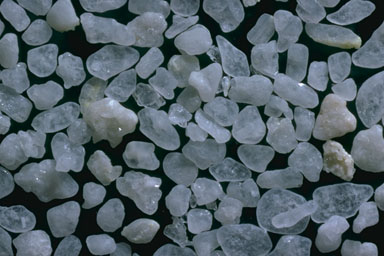

Gypsum rocks are sedimentary rocks made up of sulfate mineral and formed as the result of evaporating sea water in massive prehistoric basins. It is very soft and is used to make Plaster of Paris, casts, molds, and wallboards
Gypsum rock is usually white or gray, and a freshly broken piece sparkles in the light. Selenite, which is pure gypsum, is the main mineral in gypsum rock; other minerals found in gypsum rock are calcite and anhydrite. It forms from the evaporation of salt-water lakes in semi-desert or desert areas. Gypsum rock is common throughout the United States. It is used to make Plaster of Paris and filler materials.

Gypsum is a soft mineral, hydrous calcium sulfate. Gypsum is the standard for hardness degree 2 on the Mohs mineral hardness scale. Your fingernail will scratch this mineral—that's the simplest way to identify gypsum. The clear variety that makes up this wedge is called selenite after the pearly luster of its cleavage faces, likened to moonlight.
 Gypsum also forms concretions of selenite blades called desert roses or sand roses, growing in sediments that are subjected to concentrated brines. The crystals grow from a central point, and the roses emerge when the matrix weathers away. They don't last long at the surface, just a few years, unless someone collects them. Here's another one.
Gypsum also forms concretions of selenite blades called desert roses or sand roses, growing in sediments that are subjected to concentrated brines. The crystals grow from a central point, and the roses emerge when the matrix weathers away. They don't last long at the surface, just a few years, unless someone collects them. Here's another one. Gypsum also forms concretions of selenite blades called desert roses or sand roses, growing in sediments that are subjected to concentrated brines. The crystals grow from a central point, and the roses emerge when the matrix weathers away. They don't last long at the surface, just a few years, unless someone collects them. Here's another one.
Gypsum also forms concretions of selenite blades called desert roses or sand roses, growing in sediments that are subjected to concentrated brines. The crystals grow from a central point, and the roses emerge when the matrix weathers away. They don't last long at the surface, just a few years, unless someone collects them. Here's another one.http://geology.about.com/library/bl/images/bldesertrose.htm
read more
No comments:
Post a Comment